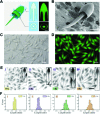Bioinspired Jellyfish Microparticles from Microfluidics
- PMID: 37040286
- PMCID: PMC10076059
- DOI: 10.34133/research.0034
Bioinspired Jellyfish Microparticles from Microfluidics
Abstract
Nonspherical particles have attracted increasing interest because of their shape anisotropy. However, the current methods to prepare anisotropic particles suffer from complex generation processes and limited shape diversity. Here, we develop a piezoelectric microfluidic system to generate complex flow configurations and fabricate jellyfish-like microparticles. In this delicate system, the piezoelectric vibration could evolve a jellyfish-like flow configuration in the microchannel and the in situ photopolymerization could instantly capture the flow architecture. The sizes and morphologies of the particles are precisely controlled by tuning the piezoelectric and microfluidic parameters. Furthermore, multi-compartmental microparticles with a dual-layer structure are achieved by modifying the injecting channel geometry. Moreover, such unique a shape endows the particles with flexible motion ability especially when stimuli-responsive materials are incorporated. On the basis of that, we demonstrate the capability of the jellyfish-like microparticles in highly efficient adsorption of organic pollutants under external control. Thus, it is believed that such jellyfish-like microparticles are highly versatile in potential applications and the piezoelectric-integrated microfluidic strategy could open an avenue for the creation of such anisotropic particles.
Copyright © 2023 Chaoyu Yang et al.
Figures






Similar articles
-
Continuous microfluidic fabrication of anisotropic microparticles for enhanced wastewater purification.Lab Chip. 2021 Apr 20;21(8):1517-1526. doi: 10.1039/d0lc01298j. Lab Chip. 2021. PMID: 33606871
-
Controllable Microfluidic Fabrication of Microstructured Materials from Nonspherical Particles to Helices.Macromol Rapid Commun. 2017 Dec;38(23). doi: 10.1002/marc.201700429. Epub 2017 Sep 1. Macromol Rapid Commun. 2017. PMID: 28863248
-
Design and batch fabrication of anisotropic microparticles toward small-scale robots using microfluidics: recent advances.Lab Chip. 2024 Sep 24;24(19):4514-4535. doi: 10.1039/d4lc00566j. Lab Chip. 2024. PMID: 39206574 Review.
-
3D shape evolution of microparticles and 3D enabled applications using non-uniform UV flow lithography (NUFL).Soft Matter. 2017 Oct 18;13(40):7255-7263. doi: 10.1039/c7sm00987a. Soft Matter. 2017. PMID: 28960218
-
Complex three-dimensional microparticles from microfluidic lithography.Electrophoresis. 2020 Sep;41(16-17):1491-1502. doi: 10.1002/elps.201900322. Epub 2020 Feb 12. Electrophoresis. 2020. PMID: 32012294 Review.
Cited by
-
Biomimetic Microfluidic Pumps for Selective Oil-Water Separation.Adv Sci (Weinh). 2025 Jul;12(27):e2503511. doi: 10.1002/advs.202503511. Epub 2025 Apr 26. Adv Sci (Weinh). 2025. PMID: 40285606 Free PMC article.
-
Nanozyme-Shelled Microcapsules for Targeting Biofilm Infections in Confined Spaces.Adv Healthc Mater. 2025 Mar;14(8):e2402306. doi: 10.1002/adhm.202402306. Epub 2024 Oct 14. Adv Healthc Mater. 2025. PMID: 39402785 Free PMC article.
-
Structural Optimization of Microfluidic Chips for Enhancing Droplet Manipulation and Observation via Electrodynamics Simulation.Cyborg Bionic Syst. 2025 Mar 6;6:0217. doi: 10.34133/cbsystems.0217. eCollection 2025. Cyborg Bionic Syst. 2025. PMID: 40051612 Free PMC article.
References
-
- Pearce AK, Wilks TR, Arno MC, O’Reilly RK. Synthesis and applications of anisotropic nanoparticles with precisely defined dimensions. Nat Rev Chem. 2021;5:21–45. - PubMed
-
- Liang Q, Bie N, Yong T, Tang K, Shi X, Wei Z, Jia H, Zhang X, Zhao H, Huang W, et al. . The softness of tumour-cell-derived microparticles regulates their drug-delivery efficiency. Nat Biomed Eng. 2019;3(9):729–740. - PubMed
-
- Mage PL, Csordas AT, Brown T, Klinger D, Eisenstein M, Mitragotri S, Hawker C, Tom Soh H. Shape-based separation of synthetic microparticles. Nat Mater. 2019;18:82–89. - PubMed
-
- Cai L, Bian F, Chen H, Guo J, Wang Y, Zhao Y. Anisotropic microparticles from microfluidics. Chem. 2021;7:93–136.
LinkOut - more resources
Full Text Sources

